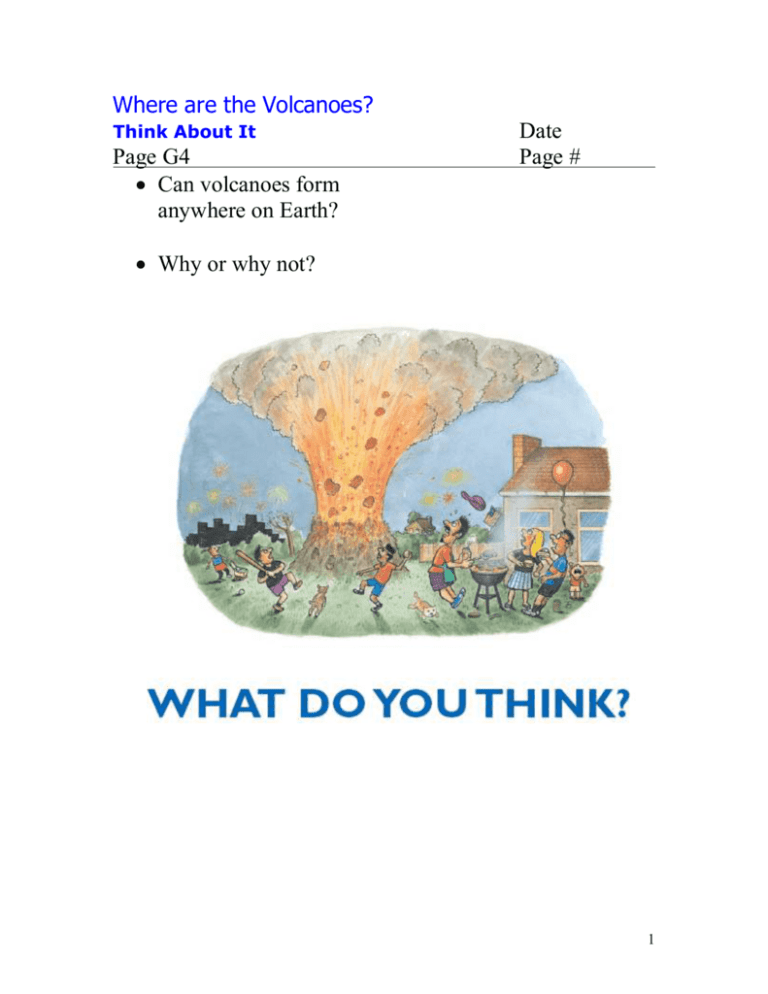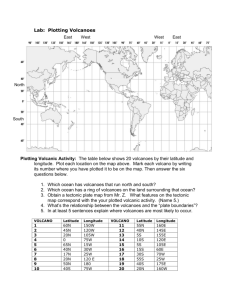Where are the Volcanoes Act. 1
advertisement

Where are the Volcanoes? Think About It Page G4 Can volcanoes form anywhere on Earth? Date Page # Why or why not? 1 Where are the Volcanoes? Investigate Pages G5-7 1a. Describe how the image of your continent is changed in shape (distorted) when it is projected onto the cylinder. Date Page # 1b. How would the lengths (east and west) of the lines compare when they are projected onto the cylinder map? 1c. How would the lengths (north and south) of the lines compare when they are projected onto the cylinder map? 1d. How would the image of a continent that is centered on the North Pole project onto the cylinder map? 2 1e. Which part of your map shows the least distortion? 2a. What do each of the four kinds of triangles represent? 2b. What do the solid red lines represent? 2c. Describe how the scale of the map changes with latitude. 2d. Does the map cover the entire Earth? Explain. Denver latitude 39.78°N longitude 104.88°W Volcano Latitude Longitude 3a. Make a data table to record your results. When complete, the data table should list 18 volcanoes. 3b. Did your class agree on the locations of the nearest historically active volcanoes? How did you resolve any differences? 3 4a. When volcanoes follow a linear pattern, draw a thick line on the world map. 4b. For the red lines that appear on the USGS map, draw thin lines on your copy of the map. 4c. Where volcanoes are less concentrated, outline (circle) the area that they cover. 5a. Are most volcanoes found in random places or do they show a trend or pattern? Explain. 4 5b. Does the USGS map show volcanoes that have not erupted during the last 10,000 years? 5c. Does the USGS map show eruptions after 1993, or new volcanoes? 5d. Does the USGS map show any volcanoes associated with the red lines in the ocean basins? 5e. What information does the map give about the size or hazard of the volcanoes? 5f. Could a volcano form in or near your state? Support your answer with evidence from this activity. 5g. What are some limitations of the evidence you used? 5 Where are the Volcanoes? Digging Deeper Pages G7-G11 Eruption of volcanoes Date Page # on average, about 60 of Earth’s 550 historically active volcanoes erupt each year Location of volcanoes They are an abundant along the edges of certain continents and floors of all ocean basins Mid-ocean ridge a continuous mountain range extending through the North and South Atlantic Oceans, the Indian Ocean, and the South Pacific Ocean These ridges are over 80,000 km long in total, and are in water depths of 1000 to 2000 m 6 Rift valley the deep central cleft in the crest of the mid-ocean ridge http://highered.mcgrawhill.com/sites/0072402466/student_ view0/chapter19/animations_and_movies.html# Magma naturally occurring molten rock material generated within the Earth It rises up into the rift valley to form submarine volcanoes At a few places along the midocean ridges, as in Iceland, volcanic activity is especially strong, and volcanoes build up high enough to form islands 7 Ocean vs. land Volcanoes that erupt on land are much more dangerous than volcanoes beneath the ocean Eruptions along the western edge of the United States have formed the Cascades volcanic mountain range Ring of Fire a pattern of volcanoes that are around the edges of the Pacific Ocean plate that slide down beneath the continents The Nazca plate moves eastward from the East Pacific Ridge and slides down beneath the west coast of South America The plate is heated as it sinks and if there is enough water then magma forms 8 Volcanoes formed by rifting Volcanoes form where two parts of the continent are moving apart from each other The continental plate is stretched and broken One of the breaks becomes the main one, and opens up to form the rift valley Lava molten rock that issues from a volcano or fissure Hot spot a fixed source of abundant rising magma that forms a volcanic center that has persisted for tens of millions years 9 http://www.wwnorton.com/college/geo/egeo/flash/2_10.sw f http://education.sdsc.edu/optiputer/flash/hotSpots.htm As the Pacific Plate moves to the northwest, away form the East Pacific Ridge, it passes over the fixed hot spot Magma from the hot spot punches its way through the moving plate to form a chain of islands 10 Seamount a peaked or flat-topped underwater mountain rising from the ocean floor Seamounts can be found far to the northwest of the Hawaiian Islands chain 11 Map projections the process of systematically transforming positions on the Earth’s spherical surface to a flat map while maintaining spatial relationships 12 Mercator projection a map projection in which the equator is represented by a straight line true to scale, the meridians by parallel straight lines perpendicular to the equator and equally spaced according to their distance apart at the equator, and the parallels by straight lines perpendicular to the meridians and the same length as the equator; there is a great distortion of distances, areas and shapes at the polar regions All lines of latitude look like they are equal in length It stops at 70° north and south latitude, because of the Mercator projection 13 USGS Map As you move away from the equator, the map becomes more and more distorted The USGS map stops at about 70º north and 70º south latitude The larger the area covered by the map, the less detail the map shows 14 Where are the Volcanoes? Check Your Understanding Page G11 1. What evidence do geologists have that volcanoes occur on the ocean floor? Date Page # 2. What is the Ring of Fire, and where is it located? 3. Where do most volcanoes on land form? 4. How are the rift valleys formed? 5. What are hot spots? Provide an example of a hot spot on Earth. 6. Why does the horizontal scale of Mercator projection increase with latitude? 15 Where are the Volcanoes? Understanding and Applying Page G12 1. What difficulties did you have finding the latitude and longitude of volcanoes? Date Page # 2. Where on Earth do most volcanoes occur? Explain. 3. Are most volcanoes on land caused by the Earth’s plates moving away from each other or moving toward each other? Explain. 4. In your own words, describe the likely cause of historically active volcanoes in: a) United States b) Aleutian Island and Southern Alaska c) The Hawaiian Island 16 5. Based on your results from this investigation, list the five states that you think are most likely to experience the next volcanic eruption. Explain each choice. 6. Of the average of 60 volcanoes that erupt in any given year, how many are likely to erupt along the Ring of Fire? 7. Why did the Mercator projection not show volcanoes near the Earth’s Poles? 8. Do most volcanoes on land occur in the Northern Hemisphere or the Southern Hemisphere? Explain. 17 Where are the Volcanoes? Inquiring Further Page G13 1. Eruptions near your community Date Page # Find out more about the historical eruptions of the volcanoes nearest your community. 2. Volcanoes and the water on Earth (the hydrosphere) Research to find answers to the following questions, and any other questions which you have formed: How do volcanoes at mid-ocean ridges affect the temperature of seawater? How do volcanoes change the chemistry of seawater? 18 How does seawater affect the composition of the volcanic rock that is formed at midocean ridges? Would volcanoes affect a small body of seawater, such as the red sea, the same way as a large ocean like the Atlantic? Can a change in the volume of volcanic rock formed at midocean ridges change sea level? 19







